Located about 2300 miles (3680 km) from the nearest continental shore, the Hawaiian Islands are the most isolated group of islands on the planet. The plant and animal life of the Hawaiian archipelago is the result of early, very infrequent colonizations of arriving species and the slow evolution of those species—in isolation from the rest of the world's flora and fauna—over a period of at least 5 million years. As a consequence, Hawai'i is home to a large number of endemic species. The radiation of species described by Charles Darwin in the Galapagos Islands which was critical to the formulation of his theory of evolution is far exceeded in the more isolated Hawaiian Islands.

Argyroxiphium is a small genus of plants in the family Asteraceae. Its members are known by the common names silversword or greensword due to their long, narrow leaves and the silvery hairs on some species. The silverswords belong to a larger radiation of over 50 species, including the physically different genera Dubautia and Wilkesia. This grouping is often referred to as the silversword alliance. Botanist P. H. Raven referred to this radiation as "the best example of adaptive radiation in plants".

Argyroxiphium sandwicense subsp. macrocephalum, the east Maui silversword or Haleakala silversword, is a rare plant, part of the family Asteraceae. The silversword in general is referred to as ʻāhinahina in Hawaiian.

The silversword alliance, also known as the tarweeds, refers to an adaptive radiation of around 30 species in the composite or sunflower family, Asteraceae. The group is endemic to Hawaii, and is derived from a single immigrant to the islands. For radiating from a common ancestor at an estimated 5.2±0.8 Ma, the clade is extremely diverse, composed of trees, shrubs, subshrubs, mat-plants, cushion plants, rosette plants, and lianas.

Wilkesia gymnoxiphium, is a species of flowering plant in the family Asteraceae that is endemic to the island of Kauaʻi in Hawaiʻi. It is classified as endangered on the IUCN Red List. Wilkesia is one of three genera, with Argyroxiphium and Dubautia that are believed to be descendant from a single species related to the North American tarweed. The members of these three genera constitute what is called the silversword alliance, a group whose exceedingly close genetic heritage is not reflected in their exceptionally diverse morphologies.

Argyroxiphium sandwicense, the Hawaiʻi silversword, or hinahina is a species of silversword. It is endemic to Hawaii. The two subspecies are separated by geography. Both subspecies are rare, threatened and federally protected.

The Mauna Loa silversword, Argyroxiphium kauense, or Kaʻū silversword, is a rare species of flowering plant in the aster family. It is endemic to the eastern and southern slopes of Mauna Loa on the island of Hawaiʻi. A. kauense occurs in mountainous shrublands, bogs, and open mesic forest. The species is managed by the National Park Service and Hawaiʻi State Department of Forestry and Wildlife. It is a federally listed endangered species of the United States. There are three known populations remaining, for a total of fewer than 1000 individuals.

Dubautia arborea, the tree dubautia or Mauna Kea dubautia, is a species of flowering plant in the family Asteraceae. A member of the silversword alliance, it is endemic to the island of Hawaiʻi. It is a shrub or small tree. It is an endangered species that is threatened by feral grazing animals.
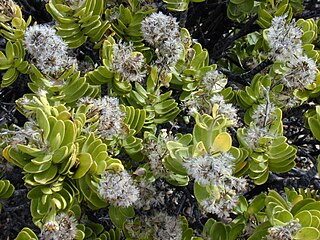
Dubautia or na'ena'e is a genus of flowering plant in the family Asteraceae. The genus was named after Joseph Eugène DuBaut (1796–1832), an officer in the French Navy who participated in Freycinet's expedition.
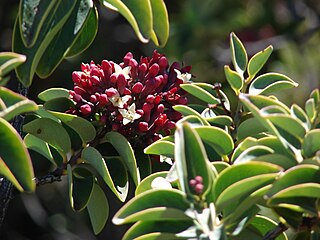
Santalum haleakalae, known as Haleakala sandalwood or ʻIliahi in Hawaiian, is a species of flowering tree in the sandalwood family, that is endemic to the islands of Maui, Lanai, and Molokai in the Hawaiian Islands, part of the United States. It grows in subalpine shrublands at elevations of 1,900 to 2,700 m, especially on the slopes of Haleakalā.
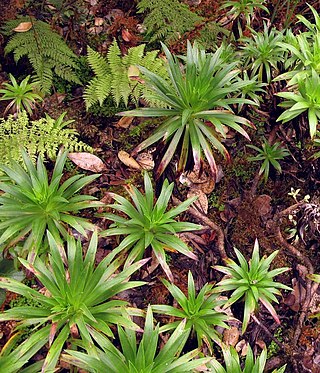
Argyroxiphium grayanum, commonly known as the greensword, is a species of flowering plant in the family Asteraceae, and a member of the silversword alliance, a group of over 50 species which are diverse in morphology and habitat but are genetically closely related.

Argyroxiphium sandwicense subsp. sandwicense, the Mauna Kea silversword, is a highly endangered flowering plant endemic to the island of Hawaiʻi of Hawaii. It is the "crown jewel" of the volcanic mountain Mauna Kea, from which it derives its English name. The Hawaiian name is ʻahinahina; it applies to silverswords more broadly. The Mauna Kea silversword was once common on the volcano, and extraordinary conservation efforts are being made to preserve the species.
Dubautia imbricata is a rare species of flowering plant in the family Asteraceae known by the common names bog dubautia and imbricate dubautia. It is endemic to Hawaii where it is known only from the island of Kauai. There are four known occurrences. Like other Dubautia this plant is known as na`ena`e.
Dubautia kalalauensis is a rare species of flowering plant in the family Asteraceae. It is endemic to Hawaii where it is known only from the island of Kauai. There is only a single known population composed of 26 plants. It was federally listed as an endangered species of the United States in 2010. Like other Dubautia this plant is known as na`ena`e.
Dubautia latifolia is a rare species of flowering plant in the family Asteraceae known by the common name koholapehu. It is endemic to Hawaii where it is known only from the west side of the island of Kauai. Like other Dubautia this plant is called na`ena`e.
Dubautia pauciflorula is a rare species of flowering plant in the family Asteraceae known by the common name Wahiawa Bog dubautia. It is endemic to Hawaii where it is known only from the Wahiawa Mountains on the island of Kauai.
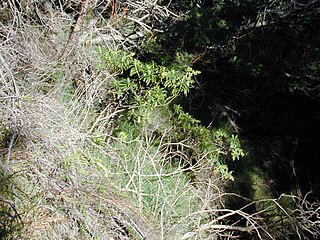
Dubautia plantaginea is a rare species of flowering plant in the aster family known by the common name plantainleaf dubautia. It is endemic to Hawaii where it is the only member of the silversword alliance that is found on all six of the largest islands. Two of the three subspecies are rare and endangered. Like other Dubautia this plant is called na`ena`e.
Argyroxiphium virescens × sandwicense subsp. macrocephalum, commonly known as the Pu'u 'Alaea greensword is a hybrid species of silversword plant in the family Asteraceae, and is a part of the silversword alliance. It is a hybrid between two taxons of silversword plant in the genus Argyroxiphium, being the presumably extinct Argyroxiphium virescens, and a subspecies, Argyroxiphium sandwicense subsp. macrocephalum. The hybrid species was discovered in 1989, when an individual flowered, which revealed hybridization features of two species of silversword. It is endemic to East Maui, primarily near the town of Pu’u Alaea, where it is seen growing beside other Argyroxiphium species. The population of the hybrid species is unknown, but is likely under threat of feral goats, and pigs that plague silversword plants.
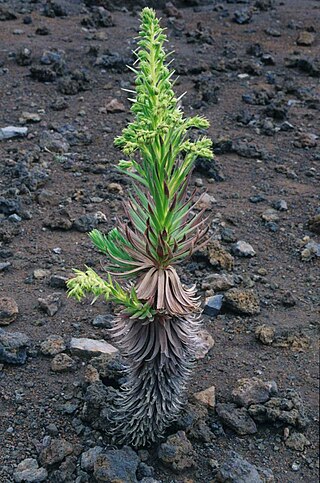
Argyroxiphium sandwicense subsp. macrocephalum x Dubautia menziesii, commonly known as the Dubautia-silversword, is a hybrid species of silversword plant in the family Asteraceae, and is a part of the silversword alliance. The hybrid was formed between Argyroxiphium sandwicense subsp. macrocephalum and Dubautia menziesii, which are both species of plant native to the Haleakalā Shield Volcano, Maui, primarily in the Haleakalā Crater, that grow in alpine and subalpine zones. A specimen was recorded by Karl Magnacca in 2006, although there isn't clear evidence of whom first described the hybrid species.

Dubautia laevigata, commonly known as the smooth dubautia, is a species of Dubautia endemic to moderate elevations on the island of Kaua'i in the state of Hawaii, United States. A member of the Silversword alliance, it only grows in the understory of mesic Hawaiian tropical rainforests. It is declining in population and is threatened by the spread of invasive species, with approximately 5500 individuals remaining.















